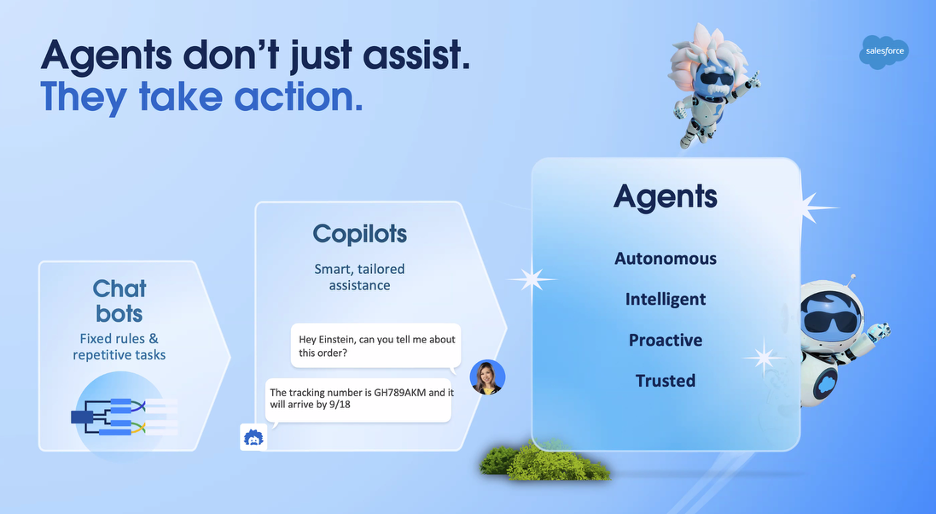Salesforce AgentForce: A New Technology for Creating AI Agents
At the end of last year, Salesforce introduced AgentForce, a groundbreaking technology for developing AI agents. This innovation has ignited a discourse regarding its potential impact on engineering challenges and the role of engineers in the future.
The purpose of this article is to provide an in-depth analysis of AgentForce. I will also share my perspective on whether this technology warrants a reevaluation of our approach to CRM system interactions or if it should be viewed as a mere extension of the global trend in artificial intelligence development.
What is AgentForce?
As outlined in Salesforce’s official press release, AgentForce is a groundbreaking and trustworthy solution that seamlessly integrates artificial intelligence into any workflow, poised to revolutionize the landscape of CRM systems. Furthermore, Salesforce has developed its own robust security framework and adheres to stringent standards for handling personal customer data, ensuring the utmost confidentiality and security of information processed by a large language model.
Several times I’ve encountered clients expressing concerns about how Salesforce can align with the global trend of implementing artificial intelligence. In October 2024, Salesforce exposed AgentForce, a comprehensive suite of modules designed to optimize workflows within Sales and Service clouds. This raises the question of whether AgentForce can enhance the productivity of sales and customer support agents. While this question may appear somewhat superficial and lacking in specificity, it is important to consider the potential benefits.
Throughout my extensive experience in various project roles, I have observed that the requirements for system development are rarely complete or well-defined. Instead, they often evolve through a process of clarification and refinement to meet the unique needs of each business. No process can be replicated exactly, even within the same industry, region, or direction.
Given this context, let us consider the implications of implementing artificial intelligence within a business. What can we anticipate?
Essential Component for Contemporary Contact Centers and Sales Platforms
In the modern contact center and sales environment, agents anticipate dedicating their time and attention to resolving specific client inquiries and crafting mutually beneficial offers. However, they do not typically engage in tasks such as searching for relevant information within the CRM system or considering the creation of correspondence to clients inviting events or presenting alternative products. AgentForce presents a significant opportunity to automate these repetitive tasks.
During the development of an agent for a one of the client, I identified numerous new opportunities.
Presently, it is feasible to implement a solution that, at the request of a manager, AI agent can display information in a user-friendly format, tailored to customer interests, thereby suggesting relevant products. This approach can be particularly effective in identifying customers who may be interested in or have access to services located near their current location. Subsequently, an email can be prepared containing a comprehensive list of products or services that align with these customer preferences. An email invitation for a distinct event, along with numerous other actions, can be prepared.
Configuring an AI agent to execute actions involves providing a detailed description of the task in plain language. This description specifies the necessary steps for the action to be performed:
“You are a marketer at ORGANIZATION_NAME.
The resort provides experiences guests can book throughout the day.
Write a marketing description for the experience below.
Make it sound unique and exciting.
Highlight the benefits of the experience.
The description should be between 80 and 100 words.”
Another few minutes were spent setting up the agent to automatically generate personalized emails to welcome guest for the next trip. Such email considers the client’s data, adds information from their event and services provided by the company, and can be written in a specific format.
For instance, to generate personalized welcoming guests email, it is necessary to provide detailed instructions in the prompt builder:
“Your name is SENDER_NAME. You work in the guest success team at ORGANIZATION_NAME, a luxury beachfront resort.
Generate an email welcoming the guest for their upcoming stay.
Guest name: GUEST_NAME.
Check-in date: NEXT_CHECK_IN_DATE.
Write a story that paints the picture of infinite possibilities at the resort and that weaves in some of the resort experiences that match the guest's interests.
List of resort experiences matching the guest's interests: EXPERIENCES.”
The majority of customization is accomplished through low-code automation. Utilizing Prompt Builder and Flow, an administrator can automate numerous workflows for themselves and their colleagues without the necessity of writing any code. So, if a business desires to modify the data that should be utilized, or the format for generating emails, for instance, it can be accomplished manually within a matter of minutes.
What if this is just a hype?
While the potential of artificial intelligence is widely discussed, it is crucial to acknowledge that this technology, comparable to other groundbreaking discoveries, must undergo a process of adaptation and awareness by humans. Frequently, the utilization of novel models, chatbots, and agents can yield unpredictable outcomes.
During the testing phase involving a substantial amount of data and assess the outcomes clients will receive, the analysis revealed that for the same set of parameters, the model could generate slightly different results. At this point, it’s difficult to determine whether the discrepancy that the model took into account of the parameters is something we’re not noticing or something else entirely.
However, the question arises:
Can a language model effectively learn from data that, due to variations in the formats of work between systems and humans, will likely be not ideal quality?
What will be the model’s response when a customer’s data record contains unverified information, inappropriate vocabulary, or other forms of erroneous content?
While exploring the details of the AgentForce implementation utilizing external sources, I came across an interesting formulation: “Customers can effortlessly extend the functionality of the platform using Flow, Mulesoft, and APEX.”
The origin of the term “easily” in this context remains unclear, but the presence of such an opportunity serves as a strong indicator of the organization’s focus on further scalability.
In December 2024, Salesforce announced the release of AgentForce 2.0. Based on the experience in creating the project using the initial version, it is pertinent to question whether this release was a fast response to competitive pressure and the prevailing trend, but not a result of careful and proven product improvement. After all, it is not feasible to say that Agentforce 1.0 is currently in a state of perfect functionality, and all users are universally satisfied with its performance.
Conclusion
AgentForce offers a range of capabilities that can significantly enhance your business operations:
* Personalized Email Generation: AgentForce can generate personalized emails based on customer data, adapting to the context and specific task requirements.
* Rapid and Flexible Information Search: It enables efficient and adaptable information retrieval from diverse sources and input formats.
* Create Field Generation template: automatically generate descriptions, ground the template using record merge fields.
Key Considerations:
* Limited Automation: AgentForce does not fully automate business processes without human intervention. While initial testing yields promising results, there is a risk of unforeseen errors or the inclusion of irrelevant data.
* Human Oversight: The generated results should be analyzed by a human expert with relevant business knowledge to ensure accuracy and completeness.
What is next?
The discussion on artificial intelligence is only at the very beginning of its evolutionary journey. Will the development of AI change the format of working with CRM systems? Definitely, and not only with them. Will AgentForce be a beneficiary of this change? Yes.
Salesforce’s solution is already being actively implemented and is gradually transforming the roles of agents and customers. The best thing you can do to understand the achievements of the trend and the caveats is to set up a simple agent, start using it in simple tasks and test the results. However, this should be done with conscious intent. The current level of technological advancement enables this solution to serve as a reasonably useful assistant, but human management should still be in place.



